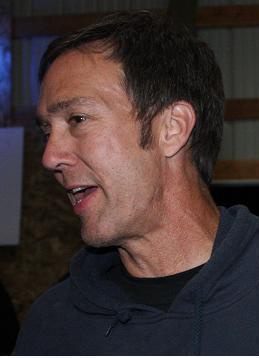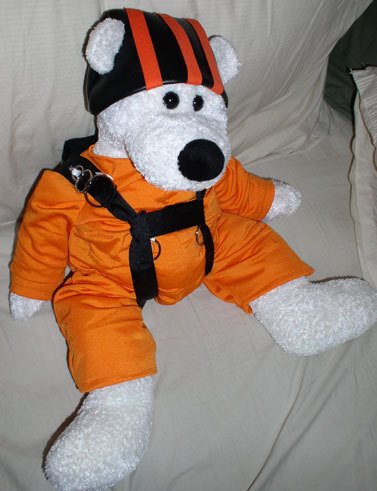billvon 3,076
> differentially when it comes accellerating from the side. Rarely will
> the accelleration be exactly parallel with the velocity of the canopy
> relative to the airmass.
To summarize - canopies weathervane. I agree.
>Air masses do not move in a constant manner.
I also agree there. My point would be that the random movements in the air are as likely to turn you downwind as they are to turn you upwind.
Chris's theory is that a canopy will weathervane "backwards," causing the tail to turn toward the relative wind and the nose away from the relative wind (in a crosswind), right? The opposite of what, well, a weathervane would do which is point into the relative wind. If you literally had a weathervane shaped like a canopy, it would always want to point in the same direction as the wind, not into the wind.
I just don't think that's true though. If it was, any crosswind disturbance would tend to cause the canopy to turn away from the wind. It would mean canopies are unstable on the yaw axis. However they are not. When a canopy is disturbed in yaw, it corrects rather than veers off. Otherwise we'd have to constantly correct left or right as we fly along.
Imagine a plane with the vertical tail on the front. It could fly straight just fine, but when it yaws just a little, it will want to continue to yaw farther and farther until it's flying backwards. That's the situation chris would be describing if canopies did follow his model.
A gust from the left would cause the canopy to yaw right. A yaw to the right increases the crosswind component from the left, increasing the yaw moment to the right, and so on.
Dave
QuoteOtherwise we'd have to constantly correct left or right as we fly along.
We do, more on some days than others.
Bear in mind that we are discussing a situation in which there is zero pilot input. Most people, whether they are aware of it or not, make these very mimor corrections just by shifting their weight in the saddle. It is only when there is absolutely no pilot input that the effects will substantially accumulate.
For Great Deals on Gear
QuoteMy point would be that the random movements in the air are as likely to turn you downwind as they are to turn you upwind
If the air mass has an average accelleration not equal to zero the movements are not really random at all. They tend to be in one direction more often than others. There should be a corresponding direction that a canopy is more likely to land in, with no input.
For Great Deals on Gear
JohnMitchell 16
Okay, yes, a crosswind gust will make a canopy turn, but not necessarily downwind.Quote
Consider the asymetrical shape of the airfoil profile. There is significantly more surface area on the front half of the profile than the back half. Any cross wind component is going to apply moore force to the front of the canopy than the back. This force differential will rotate the canopy about the vertical axis upon which the CG lies.
In fairness, the shape of the stabilizer can mitigate these effects. But certainly we cannot say that a canopy will not ever orient itself in a particular direction relative to the wind velocity.
]
If you're upwind, you will turn downwind, like Billvon stated. If you're downwind, you'll turn upwind. It's a roll of the dice as to which way you'll be facing when you land. Agreed?
QuoteThe canopy doesn't 'know' it is flying crosswind or not. It is just flying in a box of air which happens to move relative to the earth. But that doesn't affect the canopy (or any airplane in general) at all.
If a pilot wants to hold a given course and there is a crosswind component to deal with, the pilot must hold a different heading to keep the plane from drifting off down wind of the crosswind component. The only thing that counts is what you or your canopy is doing relative to the ground. If you put your canopy or a plane at a 45-degree angle to the relative wind, put the controls to natural and let go, the canopy or the plane will turn down wind. That is one of the reasons there are trim wheels on airpanes. The relative wind on the 45 degrees is greater than the relative wind on the nose of the plane or canopy. The slower the plane or canopy is moving, the greater the effect will be.
Sparky
evh 22
I can't imagine any forces making the canopy turn. (again, in constant winds that is).
Relative is the keyword here. It doesn't make a difference if the air is moving relative to the ground, or if the ground is moving relative to the non-moving air. So what, if the ground is moving in any direction. Why would that affect my canopy?
(By the way, the ground IS moving fast, due to the earth's rotation ---- but it doesn't matter)
If you are trying to fly in a straight line over the ground in a crosswind you will have to fly at an angle, depending of the speed of the wind and the airspeed of the canopy. Ofcourse slow canopies are more affected than fast ones, just as higher winds have more effect.
As you get lower, the wind decreases (=it accelerates downwind when viewed from the cloud you were in a moment ago
In short, when flying (even slightly) crosswind, you will have to keep steering "into the wind".
Flying downwind doesn't require any extra input.
And for now: Time to do some experiments


.thumb.jpg.4bb795e2eaf21b8b300039a5e1ec7f92.jpg)


Share this post
Link to post
Share on other sites